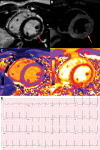Myocardial Injury Pattern at MRI in COVID-19 Vaccine-Associated Myocarditis
- PMID: 35166587
- PMCID: PMC8856022
- DOI: 10.1148/radiol.212559
Myocardial Injury Pattern at MRI in COVID-19 Vaccine-Associated Myocarditis
Abstract
Background There are limited data on the pattern and severity of myocardial injury in patients with COVID-19 vaccination-associated myocarditis. Purpose To describe myocardial injury following COVID-19 vaccination and to compare these findings to other causes of myocarditis. Materials and Methods In this retrospective cohort study, consecutive adult patients with myocarditis with at least one T1-based and at least one T2-based abnormality at cardiac MRI performed at a tertiary referral hospital from December 2019 to November 2021 were included. Patients were classified into one of three groups: myocarditis following COVID-19 vaccination, myocarditis following COVID-19 illness, and other myocarditis not associated with COVID-19 vaccination or illness. Results Of the 92 included patients, 21 (23%) had myocarditis following COVID-19 vaccination (mean age, 31 years ± 14 [SD]; 17 men; messenger RNA-1273 in 12 [57%] and BNT162b2 in nine [43%]). Ten of 92 (11%) patients had myocarditis following COVID-19 illness (mean age, 51 years ± 14; three men) and 61 of 92 (66%) patients had other myocarditis (mean age, 44 years ± 18; 36 men). MRI findings in the 21 patients with vaccine-associated myocarditis included late gadolinium enhancement (LGE) in 17 patients (81%) and left ventricular dysfunction in six (29%). Compared with other causes of myocarditis, patients with vaccine-associated myocarditis had a higher left ventricular ejection fraction and less extensive LGE, even after controlling for age, sex, and time from symptom onset to MRI. The most frequent location of LGE in all groups was subepicardial at the basal inferolateral wall, although septal involvement was less common in vaccine-associated myocarditis. At short-term follow-up (median, 22 days [IQR, 7-48 days]), all patients with vaccine-associated myocarditis were asymptomatic with no adverse events. Conclusion Cardiac MRI demonstrated a similar pattern of myocardial injury in vaccine-associated myocarditis compared with other causes, although abnormalities were less severe, with less frequent septal involvement and no adverse events over the short-term follow-up. © RSNA, 2022 Online supplemental material is available for this article. See also the editorial by Raman and Neubauer in this issue.
Conflict of interest statement
Figures





Comment in
-
Postvaccine Myocarditis: A Risk Worth the Reward?Radiology. 2022 Sep;304(3):563-565. doi: 10.1148/radiol.220252. Epub 2022 Feb 15. Radiology. 2022. PMID: 35166589 Free PMC article. No abstract available.
Similar articles
-
Cardiovascular magnetic resonance imaging and clinical follow-up in patients with clinically suspected myocarditis after COVID-19 vaccination.J Cardiovasc Magn Reson. 2024 Summer;26(1):101036. doi: 10.1016/j.jocmr.2024.101036. Epub 2024 Mar 11. J Cardiovasc Magn Reson. 2024. PMID: 38479457 Free PMC article.
-
Follow-up cardiac magnetic resonance in children with vaccine-associated myocarditis.Eur J Pediatr. 2022 Jul;181(7):2879-2883. doi: 10.1007/s00431-022-04482-z. Epub 2022 Apr 28. Eur J Pediatr. 2022. PMID: 35482094 Free PMC article.
-
Cardiac Magnetic Resonance Findings of Coronavirus Disease 2019 (COVID-19) Vaccine-Associated Myopericarditis at Intermediate Follow-Up: A Comparison with Classic Myocarditis.J Pediatr. 2023 Sep;260:113462. doi: 10.1016/j.jpeds.2023.113462. Epub 2023 May 11. J Pediatr. 2023. PMID: 37172812 Free PMC article.
-
Myocarditis following COVID-19 vaccination in adolescents and adults: a cumulative experience of 2021.Heart Fail Rev. 2022 Nov;27(6):2033-2043. doi: 10.1007/s10741-022-10243-9. Epub 2022 Apr 22. Heart Fail Rev. 2022. PMID: 35449353 Free PMC article. Review.
-
Post-acute midterm follow-up cardiac MRI findings and clinical outcomes in patients with COVID-19 vaccine-associated myocarditis: a comprehensive systematic review and meta-analysis.Infect Dis (Lond). 2024 Mar;56(3):193-205. doi: 10.1080/23744235.2023.2286289. Epub 2023 Nov 24. Infect Dis (Lond). 2024. PMID: 38000007
Cited by
-
Cardiac magnetic resonance follow-up of COVID-19 vaccine associated acute myocarditis.Front Cardiovasc Med. 2022 Nov 9;9:1049256. doi: 10.3389/fcvm.2022.1049256. eCollection 2022. Front Cardiovasc Med. 2022. PMID: 36440045 Free PMC article.
-
Oncology and cardiology positron emission tomography/computed tomography faced with COVID-19: A review of available literature data.Front Med (Lausanne). 2022 Oct 19;9:1052921. doi: 10.3389/fmed.2022.1052921. eCollection 2022. Front Med (Lausanne). 2022. PMID: 36341267 Free PMC article. Review.
-
Case report: Case series of isolated acute pericarditis after SARS-CoV-2 vaccinations.Front Cardiovasc Med. 2022 Aug 17;9:990108. doi: 10.3389/fcvm.2022.990108. eCollection 2022. Front Cardiovasc Med. 2022. PMID: 36061550 Free PMC article.
-
Imaging of Myocarditis Following mRNA COVID-19 Booster Vaccination.Radiol Cardiothorac Imaging. 2022 Mar 10;4(2):e220019. doi: 10.1148/ryct.220019. eCollection 2022 Apr. Radiol Cardiothorac Imaging. 2022. PMID: 35506135 Free PMC article.
-
Changes in subclinical cardiac abnormalities 1 Year after recovering from COVID-19 in patients without clinical cardiac findings.Heliyon. 2024 Mar 5;10(5):e27380. doi: 10.1016/j.heliyon.2024.e27380. eCollection 2024 Mar 15. Heliyon. 2024. PMID: 38495174 Free PMC article.
References
-
- Aretz HT , Billingham ME , Edwards WD , et al. . Myocarditis. A histopathologic definition and classification . Am J Cardiovasc Pathol 1987. ; 1 ( 1 ): 3 – 14 . - PubMed
-
- Ammirati E , Cipriani M , Moro C , et al. . Clinical Presentation and Outcome in a Contemporary Cohort of Patients With Acute Myocarditis: Multicenter Lombardy Registry . Circulation 2018. ; 138 ( 11 ): 1088 – 1099 . - PubMed
-
- Su JR , McNeil MM , Welsh KJ , et al. . Myopericarditis after vaccination, Vaccine Adverse Event Reporting System (VAERS), 1990-2018 . Vaccine 2021. ; 39 ( 5 ): 839 – 845 . - PubMed
Publication types
MeSH terms
Substances
LinkOut - more resources
Full Text Sources
Medical

